New tumble(mo)blog/selfveillance experiment/work-in-progress: sevensixlive.
Right now it's just flickr+twitter+delicious-w/-notes, but the hope is to add more badges, feeds, bells, whistles, etc. in the near future.
I'm a total noob when it comes to advanced web stuff, so if anyone knows of a good starter's guide to PHP and RSS (for someone who's reasonably familiar with HTML/CSS), please let me know in the comments.
[Edit 06/21 - changed link to remixed version with more feeds]
Saturday, June 16, 2007
Thursday, June 14, 2007
Saturday, June 09, 2007
Infinite in Every Direction
There's something simultaneously earthly and spiritual about the need to fill space with a regularized system. In all of endless possibility, there are only 17 ways to fill a plane with a regular 2 dimensional pattern. Mathematicians call this set The Wallpaper Group. These structures show up in religious art, and in tablecloths. Celtic scribes spent years sitting in poorly lit 10th century monasteries, creating the same type of drawings that we mindlessly scrawl on post-it notes while on the phone.
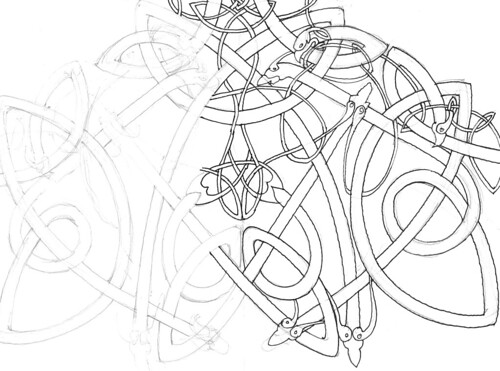
Watts Towers is a 3 dimensional doodle. Simon Rodia encased his house and yard, over a period of thirty years, with an open framework of rebar, mortar, and ceramic. He worked on it incrementally, with no master plan, the system is at once organic and modular. Uprights rise in layers that are then stabilized by outboard loops to add lateral support, these loops are then covered by more uprights and the process repeats, each layer rising a little higher than the previous.
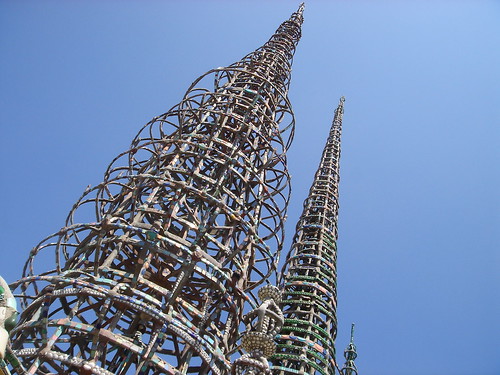
Adaptation
That ideal diagram is adapted to accomodate chimneys, benches, and the triangular shape of the lot. (No wonder they love it at Sci-Arc) He made it of materials that he was able to gather while walking along the railroad tracks and while at his job as a tile-setter. The mortar is covered in the stuff the Catalans call trencadis: shards of dishware and soda bottles, everyday detritus and trash with the logos and glazed patterns (again, patterns) still visible.
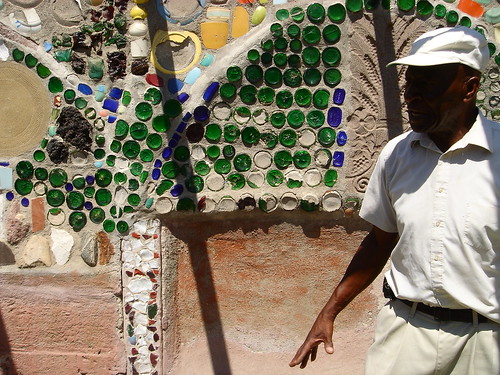
As the tour guide told us when I visited last summer: 'What most people don't know about this structure is that it is a church. Mr. Rodia would give a sermon to his neighbors here every almost every sunday, weddings and baptisms were also performed here.' In his book, Los Angeles: The Architecture of Four Ecologies, Reyner Banham positions the Watts Towers as the symbolic and geographic centerpoint of LA.
Universalism
If spatial doodling is the use of repetitive modules and motifs to fill space in a systematic way, then examples of its use in architecture would include Bucky Fuller's work with spaceframes and geodesics, and Konrad Wachsman's universal joint; both intended to be adapted to the absolute/everyday needs of prefabricated housing. The drive to find one universal system, that, with modifications, can accomodate any specific condition is also a generator of the Renaissance and Modernist grids of Bramante and Mies.
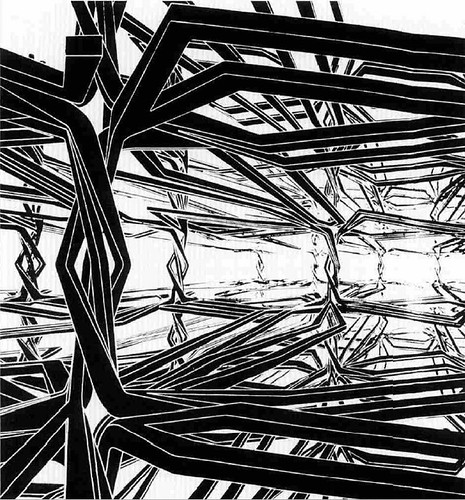
In more contemporary, exotic geometries, the Voronoi diagram is the expression of this motivator. The perfect combination of scalability, universality, and specificity, the bubble-like structure of Voronoi cells can be used to model the large-scale organization of galactic superclusters as 'cosmic foam', and the smallest scale organization of subatomic virtual particles as 'quantum foam'. It's difficult to avoid getting all mystical about this kind of formal geometry: once you start looking for it, it's everywhere. Bubbles, all the way down. The cubic grid and the octahedral/tetrahedral lattice are recognized as nothing more than special, regularized, cases of the Voronoi diagram, as are all systems of close packed Platonic Solids.

The general case of the n-dimensional diagram was described by Georgy Fedoseevich Voronoi in 1908. Antoni Gaudi was using Voronoi geometry in the lamps and wallpaper of the Casa Batllo in 1905, and in the plan of the Casa Mila in 1907.

Effulgence
In Spanish religious art, the backgrounds of Gothic altarpieces show the dwellings of the saints as an abstract effulgence, a glowing plenum of gold on gold, full of energy and geometry like the Dirac Sea.

Abstract geometries can be traced from the subjectless intricacies of Islamic patterns. These found their most elaborate expression at the Alhambra, where the numerical motifs in the ceiling at the Hall of the Ambassadors reference the seven levels of paradise. In nonmuslim art, as portraits of saints turned to portraits of people, the patterns migrated off the backgrounds and into the rugs, walls and tablecloths of the surroundings.
Syntax
As these abstract geometries move from the everyday to the otherworldly and back again, they hint at a different relationship between the immanent and the transcendant. Foregrounding a flat network of equal things, instead of a hierarchy of real and ideal, they show the possibility of another world that's accessed through syntax not semantics. It's not that the definition of the temporal is the absolute, it's that these structures are everywhere present, here and elsewhere, and what's important is the perception of pattern and relation at every level.
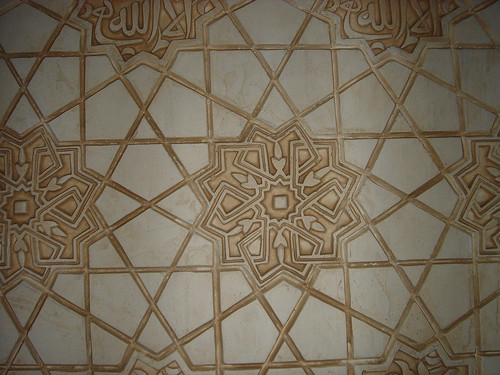

Watts Towers is a 3 dimensional doodle. Simon Rodia encased his house and yard, over a period of thirty years, with an open framework of rebar, mortar, and ceramic. He worked on it incrementally, with no master plan, the system is at once organic and modular. Uprights rise in layers that are then stabilized by outboard loops to add lateral support, these loops are then covered by more uprights and the process repeats, each layer rising a little higher than the previous.

Adaptation
That ideal diagram is adapted to accomodate chimneys, benches, and the triangular shape of the lot. (No wonder they love it at Sci-Arc) He made it of materials that he was able to gather while walking along the railroad tracks and while at his job as a tile-setter. The mortar is covered in the stuff the Catalans call trencadis: shards of dishware and soda bottles, everyday detritus and trash with the logos and glazed patterns (again, patterns) still visible.

As the tour guide told us when I visited last summer: 'What most people don't know about this structure is that it is a church. Mr. Rodia would give a sermon to his neighbors here every almost every sunday, weddings and baptisms were also performed here.' In his book, Los Angeles: The Architecture of Four Ecologies, Reyner Banham positions the Watts Towers as the symbolic and geographic centerpoint of LA.
Universalism
If spatial doodling is the use of repetitive modules and motifs to fill space in a systematic way, then examples of its use in architecture would include Bucky Fuller's work with spaceframes and geodesics, and Konrad Wachsman's universal joint; both intended to be adapted to the absolute/everyday needs of prefabricated housing. The drive to find one universal system, that, with modifications, can accomodate any specific condition is also a generator of the Renaissance and Modernist grids of Bramante and Mies.

In more contemporary, exotic geometries, the Voronoi diagram is the expression of this motivator. The perfect combination of scalability, universality, and specificity, the bubble-like structure of Voronoi cells can be used to model the large-scale organization of galactic superclusters as 'cosmic foam', and the smallest scale organization of subatomic virtual particles as 'quantum foam'. It's difficult to avoid getting all mystical about this kind of formal geometry: once you start looking for it, it's everywhere. Bubbles, all the way down. The cubic grid and the octahedral/tetrahedral lattice are recognized as nothing more than special, regularized, cases of the Voronoi diagram, as are all systems of close packed Platonic Solids.

The general case of the n-dimensional diagram was described by Georgy Fedoseevich Voronoi in 1908. Antoni Gaudi was using Voronoi geometry in the lamps and wallpaper of the Casa Batllo in 1905, and in the plan of the Casa Mila in 1907.

Effulgence
In Spanish religious art, the backgrounds of Gothic altarpieces show the dwellings of the saints as an abstract effulgence, a glowing plenum of gold on gold, full of energy and geometry like the Dirac Sea.

Abstract geometries can be traced from the subjectless intricacies of Islamic patterns. These found their most elaborate expression at the Alhambra, where the numerical motifs in the ceiling at the Hall of the Ambassadors reference the seven levels of paradise. In nonmuslim art, as portraits of saints turned to portraits of people, the patterns migrated off the backgrounds and into the rugs, walls and tablecloths of the surroundings.
Syntax
As these abstract geometries move from the everyday to the otherworldly and back again, they hint at a different relationship between the immanent and the transcendant. Foregrounding a flat network of equal things, instead of a hierarchy of real and ideal, they show the possibility of another world that's accessed through syntax not semantics. It's not that the definition of the temporal is the absolute, it's that these structures are everywhere present, here and elsewhere, and what's important is the perception of pattern and relation at every level.

Subscribe to:
Posts (Atom)
